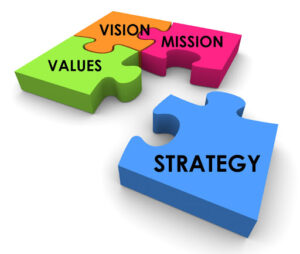A successful strategic plan
Many people like to lay the first stone in a new construction, hoping that the project will be completed very soon.
Sometimes projects are started with great enthusiasm but remain unfinished and half finished. Similarly, many people or organizations put their dreams (Business Vision) on paper, in black and white; your first stone. But as the days, weeks and years pass, his dreams are left unfinished and half finished. Why is this happening? Why can’t they make their dreams come true? Well, mainly because they forget to make a plan with well-defined goals, initiatives (improvement projects) and activities.

Now with the development of their own Strategic Plan they discover that the future of their organization is in their hands, not in political, economic or social miracles. They realize the correlation that exists between the causes and the results of their business: the better the planning, the better the results; more investment more profitability; the higher the risk, the higher the benefits; the more teamwork, the more strength to face the future; the more financially sound, the more attractive it is to shareholders, clients, collaborators and suppliers.
How to develop the Strategic Plan by Abdul Rimaaz? Developing the following three stages:
- Design business objectives.
- Design improvement initiatives or projects.
- Design improvement activities.
1.-Business objectives. They are the most important set of quantitative results for the organization. Each objective has an annual goal that forces the organization to work together to achieve it.
Examples of business objectives: Sales (pieces, weights), number of clients, profits (weights, percentage), product development, training (hours per person, man-hours), portfolio (balance, days), accounts payable ( balance, days), inventories (pieces, pesos, days), etc.
2.- Initiatives. They are the set of projects that help the organization to achieve its business objectives. In other words, initiatives are an inherent part of the way of doing business in the organization. They are not just trendy or isolated temporary activities. Remember, an initiative encompasses a set of activities. Initiatives are of greater importance than activities.
As can be seen, the initiative must be a project that adds value to the organization year after year. This error of differentiation between activity and initiative is very common among those who do not have a strategic thinking. To each idea that you come up with, ask the following questions. What is it for the organization? What does the organization gain from its execution? If you find answers, you will have found the context of the activities, and surely you will have found in each answer the design of a strategy.
3.- Improvement activities. They are the set of specific actions to be developed during the year. Each improvement activity can be carried out once or several times a year. For example, hiring the Marketing Manager is a one-time activity. Make a monthly audit of the branches. This activity can be done several times a year.
Read also: Business Consulting | the Organizational Structure
All improvement activities must have a defined person in charge and an execution date. Obviously, the more the activities complement each other and contribute to achieving the initiative, the better. Isolated activities are of no use.


